Request your feedback on 100k service recommendations
#1
2004 Volvo S40...Probably a T5 (auto). Definitely a 1.9L Turbo.
From joining and doing a bit of reading, it sounds like I should replace my daughter's timing belt. Heard the waterpump should also be tackled while in there? Plus, I've seen a crankshaft position sensor code here/there over the past year. (I'd have the lower radiator hose--that probably connects to the waterpump replaced too.)
Can anyone recommend better-than-average parts for these jobs? Would like to avoid OEM where possible -- because of unreasonably higher margins.
I'll probably pay to have these three things done..as I'm too busy to tackle myself now. But, I'll follow-up with upper radiator hose and serpentine. Maybe I should consider brake-line flush?
She has new tires/battery. I also replaced the FPR this summer. Injectors seem fine...as are their O-rings. It idles and runs well.
100k miles with oil changes in 3-5k intervals. Factory weight oil used...with synthetic blend...or 1-qt synthetic and dino mix.
Thanks for any suggestions/feedback -- to keep my daugher's trips to/from college this year safe and problem free!
<cyber-wave>
From joining and doing a bit of reading, it sounds like I should replace my daughter's timing belt. Heard the waterpump should also be tackled while in there? Plus, I've seen a crankshaft position sensor code here/there over the past year. (I'd have the lower radiator hose--that probably connects to the waterpump replaced too.)
Can anyone recommend better-than-average parts for these jobs? Would like to avoid OEM where possible -- because of unreasonably higher margins.
I'll probably pay to have these three things done..as I'm too busy to tackle myself now. But, I'll follow-up with upper radiator hose and serpentine. Maybe I should consider brake-line flush?
She has new tires/battery. I also replaced the FPR this summer. Injectors seem fine...as are their O-rings. It idles and runs well.
100k miles with oil changes in 3-5k intervals. Factory weight oil used...with synthetic blend...or 1-qt synthetic and dino mix.
Thanks for any suggestions/feedback -- to keep my daugher's trips to/from college this year safe and problem free!
<cyber-wave>
Last edited by 89Vette; 08-18-2013 at 07:54 PM.
#2
Ah yes, my youngest daughter moved into the dorms Saturday. She is driving my 2001. Good safe car for them.
There are several good online places to buy quality parts at less than dealer prices. IPD and FCP Groton and Tasca and others. My last timing belt change I bought a kit from IPD with OEM parts. It includes the belt, pump, tensioner, and idler pulley. If you replace hoses and the serpentine belt the regular auto parts store ones are fine.
The one big gotcha for this car is the CVVT gear leaking oil. Any engine with 100k miles will leak a bit of oil, crank seal, cam seals, etc. But if it suddenly starts leaving a good sized oil patch on the ground then have the CVVT looked at immediately. This gear is attached to the exhaust cam and has a little plunger-looking thing with an o-ring that becomes brittle and starts slinging oil. This oil gets all over the timing belt and, with mine, caused the belt to slip which bent all the exhaust valves. And it's happened to many others.
CVVT gear on left:
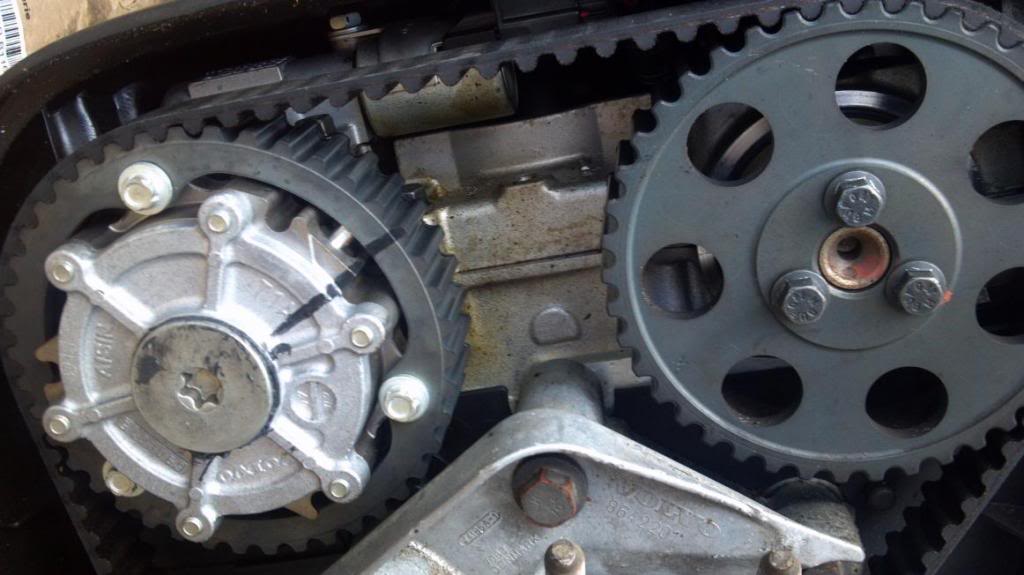
Plunger leaking:
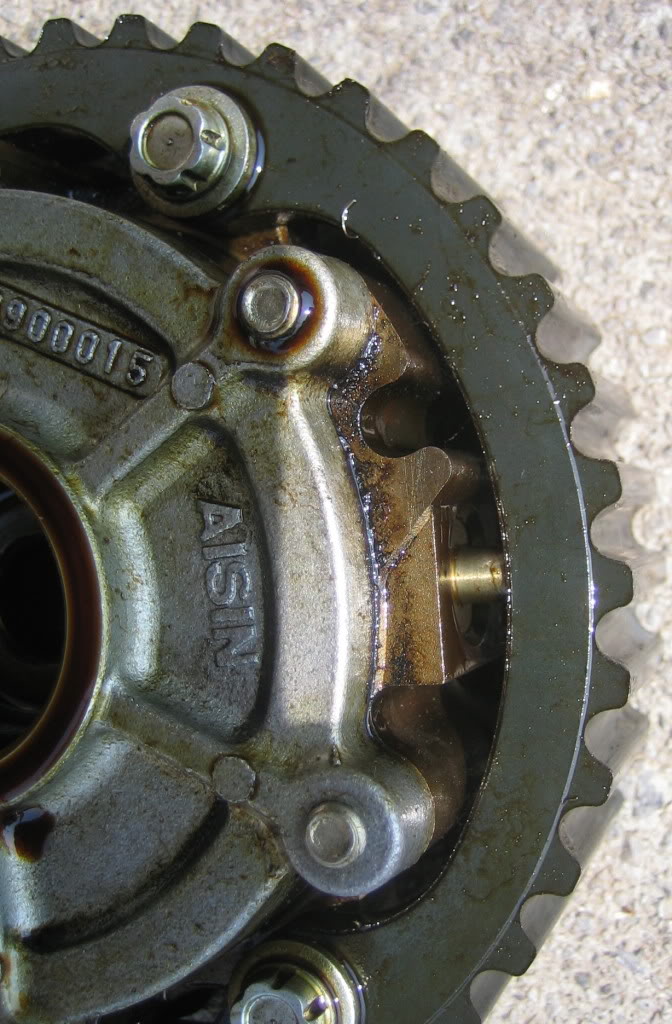
This fix. Remove outer gear leaving inner part alone.
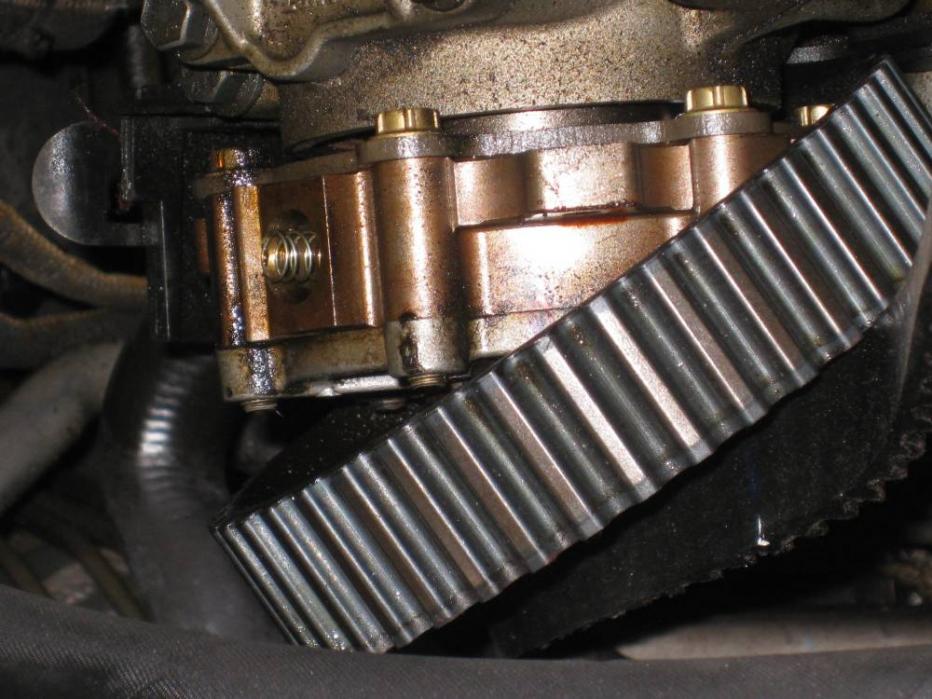
Remove plunger and replace o-ring then reinstall.
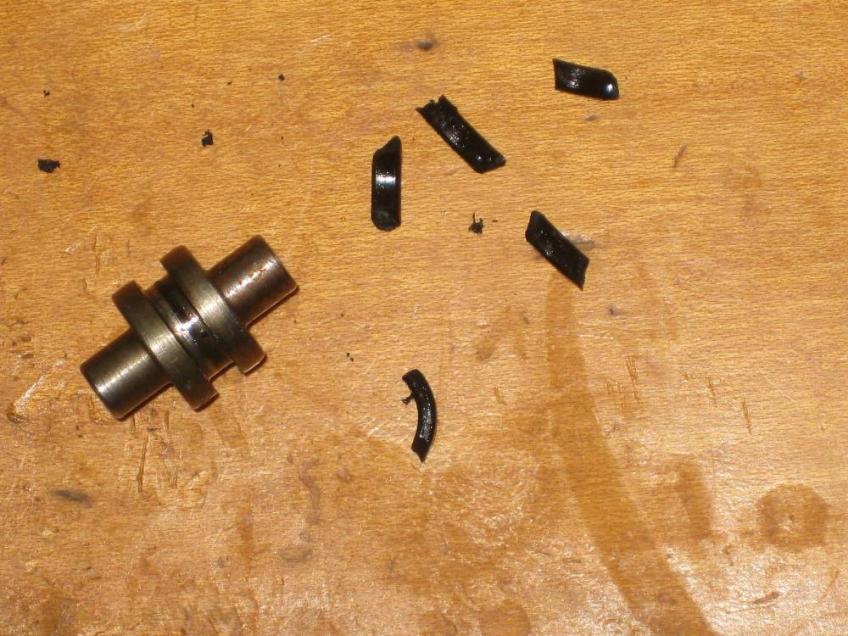
There are several good online places to buy quality parts at less than dealer prices. IPD and FCP Groton and Tasca and others. My last timing belt change I bought a kit from IPD with OEM parts. It includes the belt, pump, tensioner, and idler pulley. If you replace hoses and the serpentine belt the regular auto parts store ones are fine.
The one big gotcha for this car is the CVVT gear leaking oil. Any engine with 100k miles will leak a bit of oil, crank seal, cam seals, etc. But if it suddenly starts leaving a good sized oil patch on the ground then have the CVVT looked at immediately. This gear is attached to the exhaust cam and has a little plunger-looking thing with an o-ring that becomes brittle and starts slinging oil. This oil gets all over the timing belt and, with mine, caused the belt to slip which bent all the exhaust valves. And it's happened to many others.
CVVT gear on left:

Plunger leaking:

This fix. Remove outer gear leaving inner part alone.

Remove plunger and replace o-ring then reinstall.

#3
Is this CVVT gear part of the timing setup? Looks like it. Should this be considered standard mainence with the timing belt swap (I assume)? Does the o-ring come with a kit?
The maintenance is scheduled for Wednesday. Are you saying I should order online to get the necessary QUALITY parts? If so, I best get moving!!! And, or reschedule the service until I have the recommended pieces.
<bigears>
(BTW...The only time I've heard anything close to CVVT is in reference to constant velocity transmissions in Nissan.)
The maintenance is scheduled for Wednesday. Are you saying I should order online to get the necessary QUALITY parts? If so, I best get moving!!! And, or reschedule the service until I have the recommended pieces.
<bigears>
(BTW...The only time I've heard anything close to CVVT is in reference to constant velocity transmissions in Nissan.)
Last edited by 89Vette; 08-18-2013 at 11:56 PM.
#4
Continuous Variable Valve Timing. Known by many different names depending on car maker. Basically it allows the exhaust cam to advance or retard depending on engine needs for more torque or more horsepower. Most definitely part of the timing.
There is no kit for the little plunger. So far it's totally DIY. You have to find your own o-ring that fits. Before someone posted their solution I bought a whole new CVVT gear so I cannot help with o-ring size. I haven't heard of anyone fixing this as preventative maintenance yet. Only when it starts leaking.
Major warning: NEVER remove the inner CVVT from the exhaust cam without the Volvo specific cam holder tool in place. ONLY the outer ring gear portion when properly marked as to orientation. The reason is simple, the inner CVVT gear can be mounted at any position on the exhaust cam since it's not keyed. Once the timing belt is removed the cams will tend to move under valve spring pressure unless held in place by the cam holder tool. I write this because your mechanic may see a need for new cam seals and remove the CVVT gear without knowing to lock the cams in place.
This is what the cam holder tool looks like:
VOLVO CAMSHAFT ALIGNMENT GAUGE V9995452
This is what it looks like bolted to the cams; (drivers side of engine)
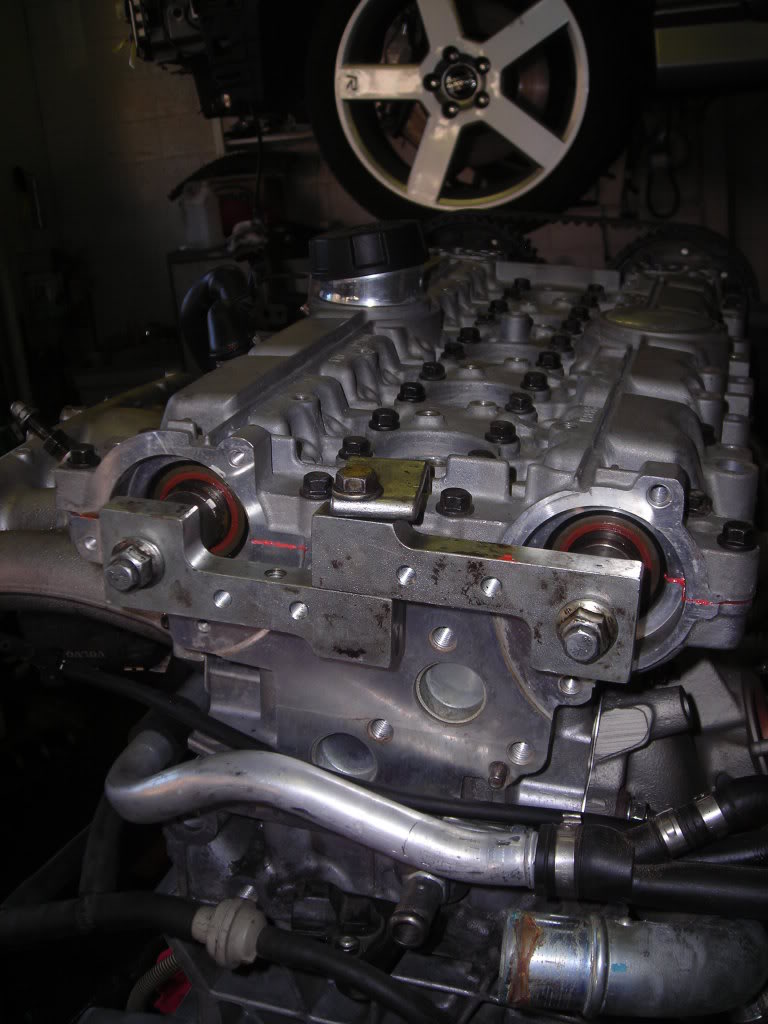
There is no kit for the little plunger. So far it's totally DIY. You have to find your own o-ring that fits. Before someone posted their solution I bought a whole new CVVT gear so I cannot help with o-ring size. I haven't heard of anyone fixing this as preventative maintenance yet. Only when it starts leaking.
Major warning: NEVER remove the inner CVVT from the exhaust cam without the Volvo specific cam holder tool in place. ONLY the outer ring gear portion when properly marked as to orientation. The reason is simple, the inner CVVT gear can be mounted at any position on the exhaust cam since it's not keyed. Once the timing belt is removed the cams will tend to move under valve spring pressure unless held in place by the cam holder tool. I write this because your mechanic may see a need for new cam seals and remove the CVVT gear without knowing to lock the cams in place.
This is what the cam holder tool looks like:
VOLVO CAMSHAFT ALIGNMENT GAUGE V9995452
This is what it looks like bolted to the cams; (drivers side of engine)

Last edited by Hudini; 08-19-2013 at 07:34 AM.
#6
Hudini, Thanks for the explanation! I had heard of variable valve timing, but wasn’t sure how it worked. I’m also familiar with SBC (Gen 1) performance cam theory after building a 383 myself. That said, I have to wonder about the real benefit of CVVT – if the exhaust port flow was sufficient. I assume holding the exhaust valve closed longer generates more torque while the opposite benefits HP. The exhaust gases can blow out fast enough, what’s the need? Are the requirements higher because of the FI characteristics of a turbo engine? IOW, that they couldn’t get enough flow w/o unreasonably large exhaust ports? Obviously port velocity matters too…
My local mechanic SAYS they have tons of experience with all types of vehicles – including Volvos. Judging by their facility and customer feedback, I believe them. For the timing belt and tensioner, they’ll use a Gates brand. They don’t buy the “kit”. For the waterpump and CPS, they purchase Volvo parts. Do you see a problem with these part selections…or the lack of complete timing kit for service?
My local mechanic SAYS they have tons of experience with all types of vehicles – including Volvos. Judging by their facility and customer feedback, I believe them. For the timing belt and tensioner, they’ll use a Gates brand. They don’t buy the “kit”. For the waterpump and CPS, they purchase Volvo parts. Do you see a problem with these part selections…or the lack of complete timing kit for service?
#7
Yes, absolutely. The cams do tend to move but it's easy to realign the marks. I am still looking for a product to wedge between the cam gears to hold the cams from moving in the first place.
#8
Hudini, Thanks for the explanation! I had heard of variable valve timing, but wasn’t sure how it worked. I’m also familiar with SBC (Gen 1) performance cam theory after building a 383 myself. That said, I have to wonder about the real benefit of CVVT – if the exhaust port flow was sufficient. I assume holding the exhaust valve closed longer generates more torque while the opposite benefits HP. The exhaust gases can blow out fast enough, what’s the need? Are the requirements higher because of the FI characteristics of a turbo engine? IOW, that they couldn’t get enough flow w/o unreasonably large exhaust ports? Obviously port velocity matters too…
My local mechanic SAYS they have tons of experience with all types of vehicles – including Volvos. Judging by their facility and customer feedback, I believe them. For the timing belt and tensioner, they’ll use a Gates brand. They don’t buy the “kit”. For the waterpump and CPS, they purchase Volvo parts. Do you see a problem with these part selections…or the lack of complete timing kit for service?
My local mechanic SAYS they have tons of experience with all types of vehicles – including Volvos. Judging by their facility and customer feedback, I believe them. For the timing belt and tensioner, they’ll use a Gates brand. They don’t buy the “kit”. For the waterpump and CPS, they purchase Volvo parts. Do you see a problem with these part selections…or the lack of complete timing kit for service?
Nothing wrong with your part selections. Idler, Tensioner, Water Pump, and Timing Belt are the 4 inner parts. On the outside there is the serpentine belt and the belt tensioner.
#10
When you built your 383, did you install the cam straight up? This is a compromise position. You could have also installed it retarded for more horsepower but a loss of torque or advanced for the opposite effect. With variable valve timing you get the best of both worlds as your engine computer advances or retards the exhaust cam automatically. This works for all engines, turbo or normally aspirated.
I installed my 383 cam advanced to improve responsiveness. Also, the heads and headers I used were head/shoulders above most aftermarket heads -- especially on the exhaust side. So, they didn't need as much exhaust breathing anyway...hence my prior comment/post.
It's clear how holding valves closed will generate more torque. It's not as clear how lengthening that interval helps horsepower....though I understand scavenging...and evacuating exhaust's "ability" to pull fumes behind it. Cam overlap is so small in most production cars that scavenging seems widely ineffectual.
#11
Ahhh, but a turbo doesn't need scavenging as the turbo just stuffs more air in! (I really like turbos.) Forced induction cams generally have a wide LSA. The newest Corvette ZR1 uses a 122.5 degree LSA with it's supercharged engine. N/A cams are, what, 106-110 degrees?
If you look at the top picture you can see the intake cam gear has no CVVT. Just a plain old cam gear. All the 2000-2004 1.9L turbo engines are the same with this. Not sure about the newer 2004.5+ Volvos though.
If you look at the top picture you can see the intake cam gear has no CVVT. Just a plain old cam gear. All the 2000-2004 1.9L turbo engines are the same with this. Not sure about the newer 2004.5+ Volvos though.
#12
Carbed motors are in the 100's range. FI motors are typically 112-117 LSA...at least on SBC Gen1 motors. My OEM engine was a whopping 117 -- which seemed rather large for a longtube TPI making all it's power by 4500rpms. Now, I'm running 111 LSA. When you get down below 110ish, it gets harder for the ECM to monitor O2 readings. That's because you start getting reversion contamination. So, people are often forced to "tune out" closed loop operation.
Thanks for your help, Hudini! The new belt(s) are in...as is the tensioner, water pump and radiator hoses. I did the stat too. Total cost was $930. At least the "ex" split it with me. Decent peace of mind for an over-the-road commuting daugher!
What else might I do? plugs and wires?
Is there an easy (cheaper) fix for the check valve that sits "behind" the brake booster? It's had a small leak for years but I won't pay friggin' $150 to replace it! LOL Give me a break. (The only symptom is harder brakes upon start-up after a long rest. Even then, it disappears immediately. It may have a code for it too.)
She's got new tires/brakes too.
Thanks for your help, Hudini! The new belt(s) are in...as is the tensioner, water pump and radiator hoses. I did the stat too. Total cost was $930. At least the "ex" split it with me. Decent peace of mind for an over-the-road commuting daugher!
What else might I do? plugs and wires?
Is there an easy (cheaper) fix for the check valve that sits "behind" the brake booster? It's had a small leak for years but I won't pay friggin' $150 to replace it! LOL Give me a break. (The only symptom is harder brakes upon start-up after a long rest. Even then, it disappears immediately. It may have a code for it too.)
She's got new tires/brakes too.
#13
With this one it has an ignition system similar to the old GM "wasted spark" DIS. 2 coil-on-plugs, 2 wires, 4 plugs. The coils firing 2 cylinders at once. Many times the plastic parts that extend down over the plugs will get a hairline crack where the spark jumps to the head causing a misfire. You feel it when accelerating mostly. They will ohm good too so look for the cracks. Replacing the plugs would be good, but I'd leave the coils and wires until it starts missing.
I've bought coils at Advance and Autozone before. I was pleasantly surprised at Autozone when a genuine Volvo OEM coil popped out of the Autozone box. And at $44 it was the lowest cost. Very strange.
I've bought coils at Advance and Autozone before. I was pleasantly surprised at Autozone when a genuine Volvo OEM coil popped out of the Autozone box. And at $44 it was the lowest cost. Very strange.
Thread
Thread Starter
Forum
Replies
Last Post
ckeel4
For Sale / Trade - Archive
0
06-12-2011 10:41 AM



